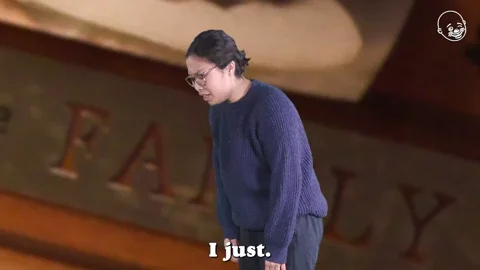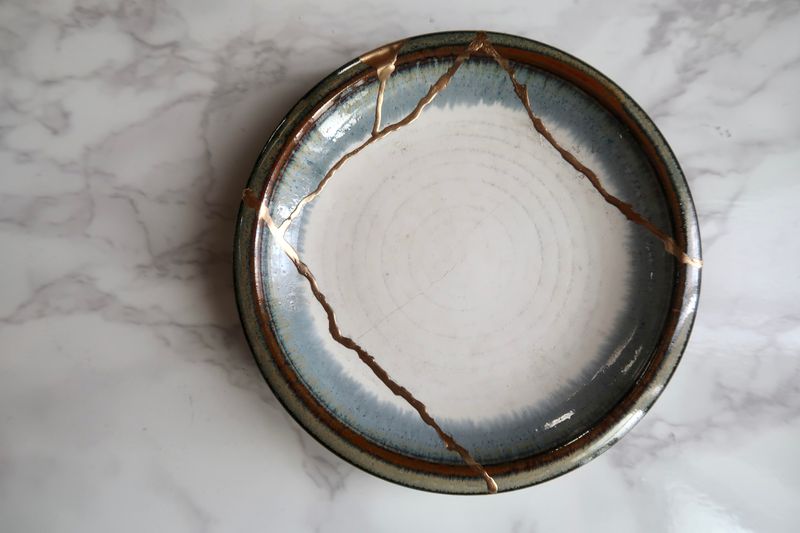
This logo isn't an ad or affiliate link. It's an organization that shares in our mission, and empowered the authors to share their insights in Byte form.
Rumie vets Bytes for compliance with our
Standards.
The organization is responsible for the completeness and reliability of the content.
Learn more
about how Rumie works with partners.
Did you know that having a mindset like this...

...can lead to this?

Be it acting professionally, having a test, or dealing with responsibility, people today place so much pressure on themselves to never make a single mistake.
Yet when we eventually do, we are overcome with a heavy weight of shame. What if there was another way to look at failure?
Explore the art of "golden joinery", or kintsugi, and how its philosophy shows that failure is something natural and beautiful, and can be a tool for growth.
What is Kintsugi?
Kintsugiis a Japanese art that repairs broken pottery using lacquer, an adhesive sap from varnish trees. Then, the lacquer is decorated with gold dust.
It's a practice that dates back around the 16th century, and its goal was to repair pottery in an aesthetically pleasing way.
 Photo by Riho Kitagawa on Unsplash
Photo by Riho Kitagawa on UnsplashPeople who saw these repairs enjoyed the unique imagery that the cracks created. They viewed this as a metaphor for failures and accidents in their lives. They felt that one's history (even with failures) should be presented and appreciated in its entirety.
Principles of Kintsugi Philosophy
Kintsugi draws from other philosophies, being most influenced by Zen Buddhism. They are listed below:
Wabi-sabi — imperfections are seen as beautiful, meaningful, and authentic, and we should accept things as they are.
Mushin — a mental state where thoughts, emotions, and ego are absent, emphasizing non-attachment and the acceptance of change.
"Waste Not, Want Not" — a saying that means making the most of something rather than desiring more. For example, when a bowl breaks, you should fix it rather than buy a new one.
The overall principle is simple: there is beauty in one's flaws and scars. Such things do not lessen one's value. Though we can't avoid or remove mistakes, mending and embracing them brings out that beauty.

Did you know?
This Byte was created by a volunteer professional that wanted to share this insight to help you succeed - no agenda, no cost.
Kintsugi Philosophy and Failure
With these ideas, we begin to see kintsugi's perspective on failure:

Failure is a natural part of life. Imperfection has as much value as perfection. Inevitably, everyone will make a mistake, so burdening oneself with shame because of it is almost pointless.
Failure should be at the very least acknowledged, and at the most celebrated. The gold in the cracks is a statement that even failure is worth being adorned with something rare and valuable.
Even more, one can view the gold lacquer as addressing and mending past hurts and mistakes, and through the process, one can return to a strong semblance of self.
If life changes with or without mistakes, then you at the moment (with or without mistakes) are good enough. Fretting about what was and what could be will lead you to miss appreciating what is now.
Even if this belief is hard to accept, the necessity to be better than how you are now requires a person to address their present self — then find the steps needed today to lead to a better tomorrow.
In short, if you think you aren't worthy, you can become worthy.

Apply Kintsugi Philosophy to Your Life
How would you apply these perspectives when faced with failure?
Go Easy On Yourself
Take a second to realize the feelings of guilt or shame that come upon you. By recognizing these feelings, you can make the conscious decision to move past them, and not let them take control of you.
The best way to achieve this is to take deep breaths through the stomach. This will help you calm down enough to label your feelings properly.

Make the Most of Your Mistakes
Mistakes offer two things: a chance to fix and to learn something. By taking the chance to problem-solve the issue and reflect on it, you gain wisdom and experience about life.
The best way to achieve this is to see what can be remedied with your own abilities, and take time to think about what caused the mistake and how to avoid it in the future. Journaling is also a great method for reflection!

Accept and Forgive Yourself
Accept the idea that you currently are more than enough, and also a work in progress. By having compassion towards yourself, you give the space to be okay in the present, all the while allowing yourself to move from the past and grow towards the future.
The best way to achieve this is to have the belief that you're a good person even with mistakes. If this is hard to accept, another option is to understand the fact that feeling bad about your mistakes hasn't helped you feel better about yourself.
Quiz: A Mistake at Work
 Photo by JESHOOTS.COM on Unsplash
Photo by JESHOOTS.COM on UnsplashDuring work, you're stressed with the amount of work you have. A coworker comes to ask you for something, but you snap at them in a harsh tone. They leave upset.
You begin to feel sorry for this mistake you made. Following kintsugi philosophy, what do you do in this scenario?
A. Take deep breaths to calm down, let your emotions pass, forgive yourself, and forget about it.
B. Take deep breaths to calm down, let your emotions pass, then reach out to the coworker to apologize for your behavior.
C. Reflect later on what caused you to be stressed, and see how you can work to better reduce or manage stress.
D. Remind yourself that you're still learning, and that you're worthy of forgiveness.
Quiz
Following kintsugi philosophy, what do you do in this scenario? Select all that apply:
With "A", forgiveness before fixing a mistake doesn't address how your actions have affected others. "B", "C", and "D" are the steps needed to properly address the mistake as a whole. To calm down, remedy your mistake, reflect on it, and forgive yourself exemplifies the philosophy of kintsugi.
Take Action
To err is human, to forgive divine.
— Alexander Pope, English poet, 1711
This quote summarizes the point of kintsugi philosophy well, in that making mistakes is part of being human, and having mercy and empathy during these mistakes is very important — for it is through these mistakes that we learn to be better towards each other and towards ourselves.
Once broken, we are rebuilt to something new — our form similar to the past, but now adorned with kindhearted revival.

To practice kintsugi philosophy in your daily life:
This Byte has been authored by
RJ Valencia
Instructional Designer
MS
